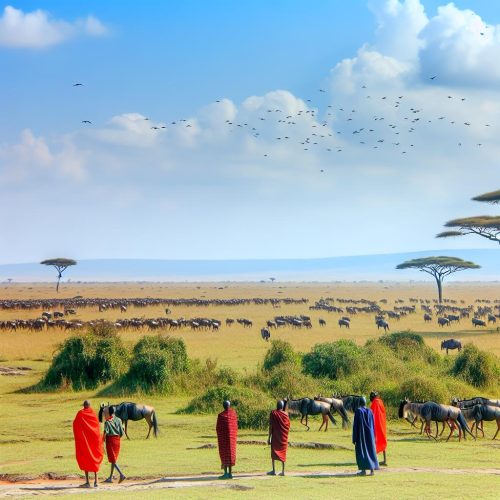Understanding the Great Migration
The Great Migration stands as one of the most awe-inspiring natural events on the planet. Annually, this remarkable event unfolds primarily within the boundaries of the Maasai Mara in Kenya and the Serengeti ecosystem in Tanzania. It involves the movement of vast numbers of herbivores, most notably over a million wildebeest, accompanied by a significant number of zebras and other grazing animals. The primary driving force behind this migration is the relentless search for fresh pastures and water sources. This widespread movement of animals is not only astonishing due to its sheer scale but also for the dramatic interactions between predators and their prey that it involves.
Timing of the Migration
The Great Migration is essentially a year-round phenomenon, with different stages unfolding over the months. The apex of the migration typically reaches the Maasai Mara between July and October. This is the time when visitors can witness some of the most dramatic scenes, particularly the mass crossings of the Mara River. This phase is crucial as it often involves perilous crossings where animals face not just the challenge of strong currents but also lurking predators, adding to the dramatic story of survival that unfolds during this period.
The River Crossing
The Mara River is a formidable obstacle that the migrating animals must overcome. Each year, the river crossing is characterized by its intensity and inherent danger. Crocodiles, some of the river’s most fearsome predators, often lie in wait to prey upon the crossing herbivores. Additionally, the swift current of the river presents a significant obstacle, and many animals, despite their efforts, do not survive the crossing. Nevertheless, for the surviving animals, this event is a pivotal part of the migration, and for those who witness it firsthand, it offers a unique spectacle that creates unforgettable memories.
Planning a Safari in the Maasai Mara
For those contemplating a safari to catch a glimpse of the Great Migration, timing is a critical factor. To maximize the chances of witnessing not just the migration itself but also the dramatic river crossings, a trip should ideally be planned between July and October. This is the period when the crossings of the Mara River are most frequent and thus, the best time to visit.
Choosing Accommodation
The Maasai Mara offers a variety of accommodation options, ranging from luxury lodges to more rustic campsites. The choice of accommodation should be influenced by the proximity to the migration routes. Ideally, staying at places strategically located near known crossing points or within the Maasai Mara reserve itself can provide ample opportunities to watch the spectacle unfold up close. These choices can greatly enhance the safari experience, providing both comfort and convenient access to the migrating herds.
Sustainable Tourism Practices
Participating in a safari brings with it the responsibility of ensuring that the impact on the environment is minimized. Sustainable tourism practices are crucial in ensuring that the natural beauty and ecological balance of the Maasai Mara can be preserved for future generations. This includes working with tour operators who are committed to sustainable practices, such as adhering to all park regulations, maintaining respectful and safe distances from wildlife, and minimizing environmental impact. Additionally, selecting operators who actively participate in local conservation efforts can further enhance the value of the experience. For more information on planning a responsible safari, one can visit the Maasai Mara official website.
Understanding the Role of Predators
As the herbivorous creatures undertake their perilous journey, the Great Migration also presents a unique opportunity to observe the roles of predators within this ecosystem. Predators such as lions, cheetahs, and leopards find increased hunting opportunities during the migration due to the abundance of prey. This creates a fascinating dynamic where guide and visitor alike can observe the instinctual behaviors that define the predator-prey relationship. These predators are not merely hunters; they are integral to maintaining the ecological balance, ensuring that only the fittest herbivores survive to continue their journey.
In conclusion, the Great Migration in the Maasai Mara is a dynamic and intricate event, offering an unparalleled wildlife spectacle that continues to astound and intrigue. By planning appropriately regarding the timing and choosing the right accommodation, alongside patronizing ethical and sustainable safari operators, visitors can both enrich their experiences and contribute to the conservation of this incredible natural phenomenon. The careful balance of human interaction and ecological preservation ensures that the Great Migration will remain an enduring spectacle for generations to come.
